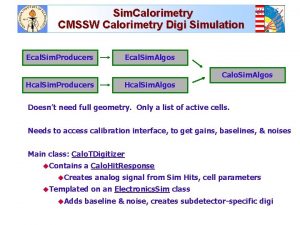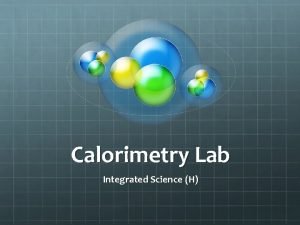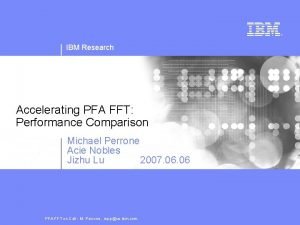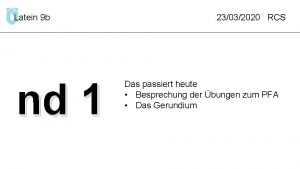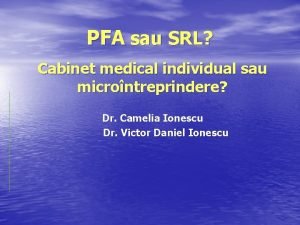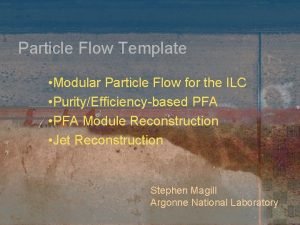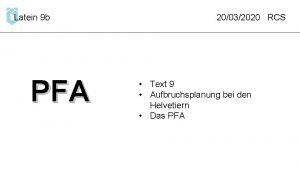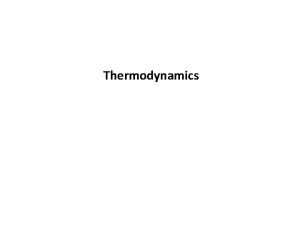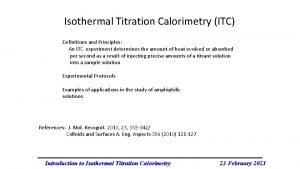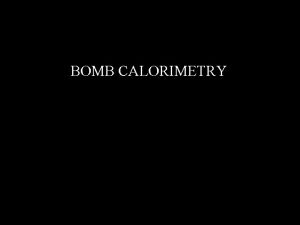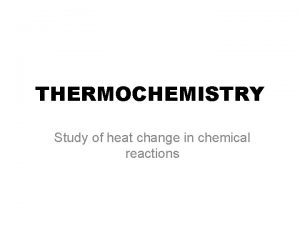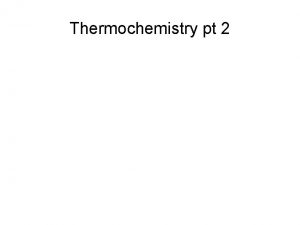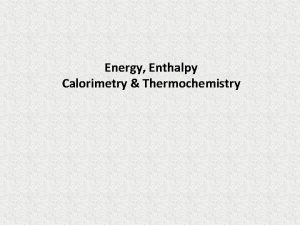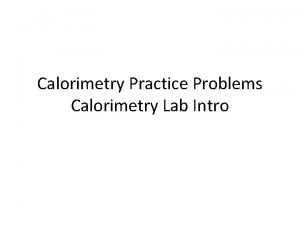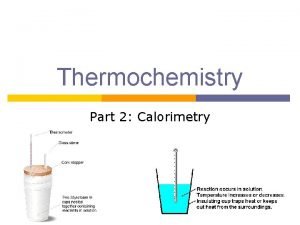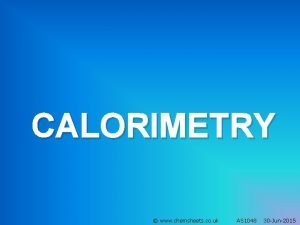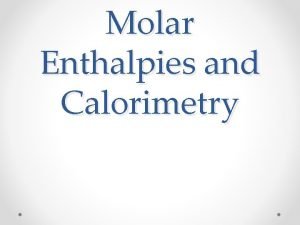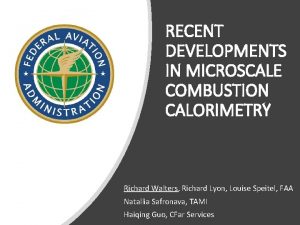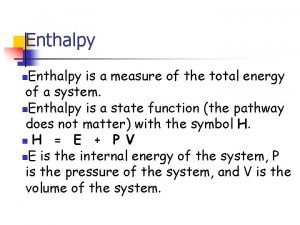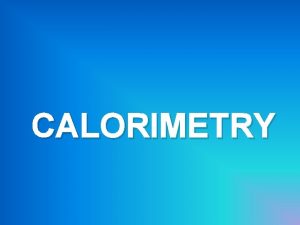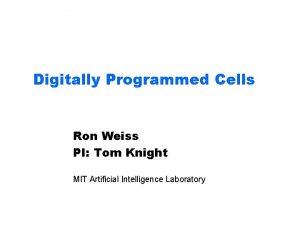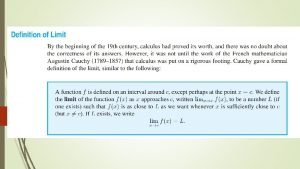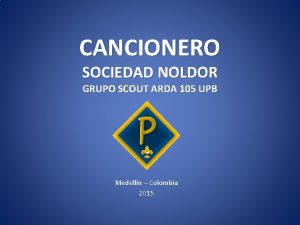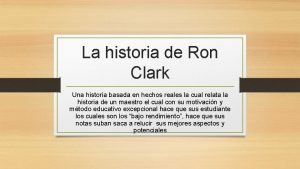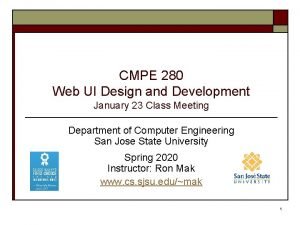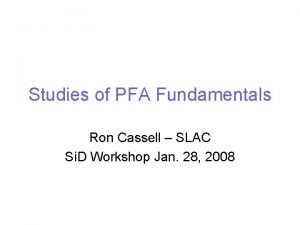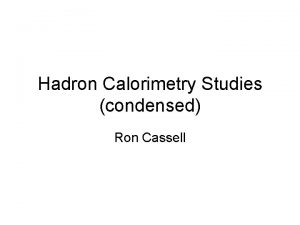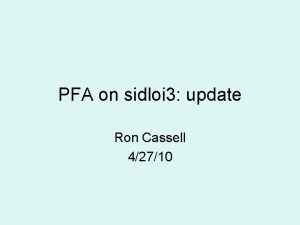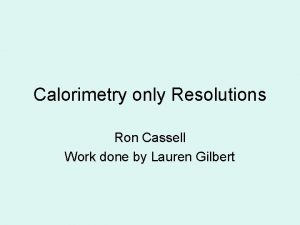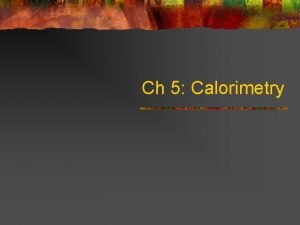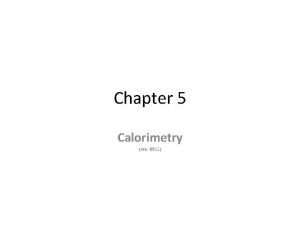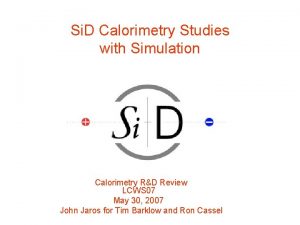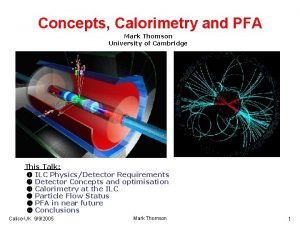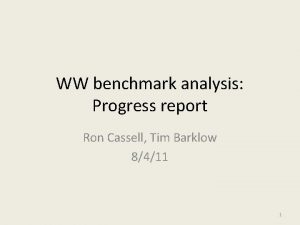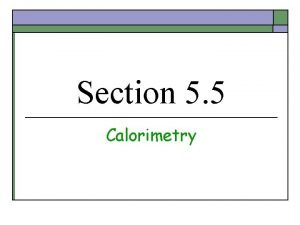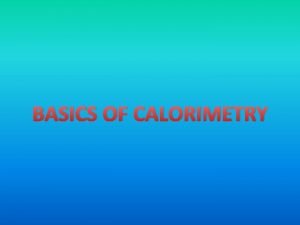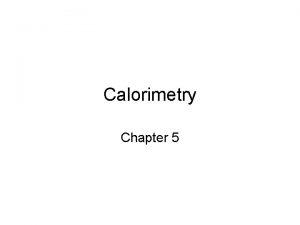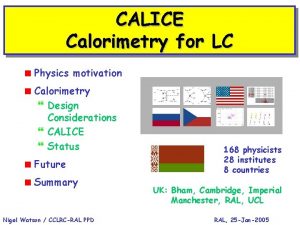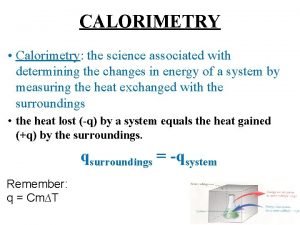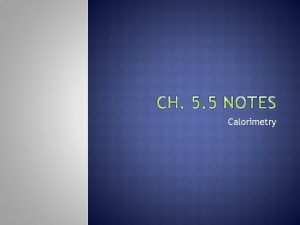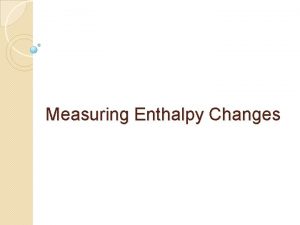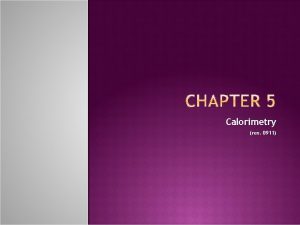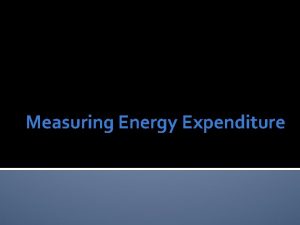Simulation calorimetry studies without a PFA Ron Cassell





































- Slides: 37

Simulation calorimetry studies without a PFA Ron Cassell – SLAC Si. D Workshop April 11, 2007

Hcal design parameters • • • Absorber material (W, Steel, Cu, Pb, other? ) Active material (Gas, Plastic) Segmentation Total lambda, and lambda/layer If plastic, analog or digital Other parameters (B field, inner radius, etc. ) probably driven by features other than neutral hadron reconstruction 2

Designing for PFlow • Vary design parameters, tune PFlow algorithm and analyze a set of physics processes. • Figure of merit: dijet mass resolution • Not yet there with PFlow algorithms ? • Even when we can, will need to understand results at a more fundamental level. • So … see what we can find out about Hcal parameters -> dijet mass resolution in the context of a PFlow algorithm without a Pflow algorithm 3

Plan • In the context of PFlow, the Hcal measures neutral hadrons. • Study energy resolution varying parameters • Quantify effect of energy resolution on dijet mass resolution • Study shower spread varying parameters • Study confusion as a function of shower spread • Quantify effect of shower spread on confusion • Quantify effect of confusion on dijet mass 4

So far … • Effect of varying design parameters on intrinsic resolution of neutral hadrons has been quantified. (Not a complete study of entire parameter space, but enough to get a good idea of variations) • Effect of intrinsic neutral hadron resolution on dijet mass resolution (no confusion) has been quantified. Within the range of resolutions of the parameter space studied, there is at most a tiny effect on dijet mass resolution. • Differences in radial and transverse spread in neutral hadron showers have been observed for gas/plastic active elements, with some attempts to quantify them. • Some attempts to quantify shower spread -> confusion, but so far only hints. 5

Energy resolution studies • Single particles in infinite detector • Energy sums in mono-energetic jets: full detector simulations, requires adding energy from Ecals, imposes physics distribution of particles. Remove as yet unknown identification problems by cheating on pattern recognition • Dijet mass resolution in physics events: impose physics distribution of jet energies and particles in jets 6

Single particle resolution: parameter space • Vary absorber, active element, segmentation, analog/digital, depth of calorimeter • Infinite parameter space, but with finite comparisons can find some trends • Basic comparisons with (W, SS)X(gas, plastic) • For a more complete set of resolution curves, see http: //www. slac. stanford. edu/~cassell/Si. DHcal. St udies. ppt 7

8

Single particle resolutions from isolated detector studies • Absorber: SS better than W, especially at higher energies. Cu similar to SS, Pb worse than W at lower energies. For fair comparison, need to compare fixed lamda per layer configurations. • Active element: Scint better than gas below ~15 Ge. V • For digital readout, significant degradation at higher energies for coarser segmentation • Resolution gain for thicker Hcal quantified • No resolution curve has flat 1/sqrt(E) dependence as function of E 9

Energy sums in mono-energetic jets • Full detector simulations • Still cheat on pattern recognition • Look at “effective” neutral hadron resolution • Use rms 90, mean 90, and alpha=(rms 90/mean 90)*sqrt(E) for comparisons of energy sums 10

11

Alpha: . 171 . 162 . 204 . 194 Alpha: . 168 . 343 . 156 . 277 . 216 . 363 . 196 . 300 12

Energy sum results • Can now track single particle resolution curve to effective resolution (at 3 jet energies) to jet energy resolution • Beware, big difference in single gaussian fit for effective resolution and rms 90. • Rms 90 should be fine for comparisons • But we really want the dijet mass resolution 13

Pattern recognition cheating analysis • Take all tracker and calorimeter hits created by a final state particle. For now, use the Generator final state particles. • For charged particles with > 3 tracker hits, create perfect momentum reconstructed particle. Use pi mass for energy. • For neutrals, and charged with less than 4 tracker hits, use calorimeter hits and calibration to determine energy of particle. • Find position of core cluster for direction • Feed Reconstructed. Particles to jet finder • Use ZZ->nunuqq events at 500 Ge. V, q=uds. • Ask jet finder for exactly 2 jets • Look at dijet mass with both jets |costheta|<. 8 14

15

16

Neutral hadron energy resolution results • With no confusion (perfect pattern recognition) a Hcal with 70% worse intrinsic resolution (at low energies) results in less than 5% broader Z mass peak in 500 Ge. V zz events • Many factors still not taken into account, but all tend to spread the peak, thus reducing the difference. • Can we understand this result? Perhaps we should look at mass resolution analytically. 17

Need to be guided by analytical calculations! • • Effective mass resolution: M 2 E 1 E 2(1 - cos 12) d. M 12/M 12 ½(d. E 1/E 1 + d. E 2/E 2 + ……) Elementary considerations show: 3 -4% jet energy resolution required NOT d. E/E = 30%/√E Physics simulations needed to more accurately specify x: d. E/E=x Morse/Partridge April 2007 FNAL 18

How Well is PFA Doing? • Interesting study in draft DCR PFA section • Jet energy resolution in the case of ee qq (light quarks only) at several center of mass energies from 50 to 500 Ge. V for the case of the GLD detector reconstructed by GLD-PFA. It showed d. E/E 85%/√E for highest energy. Plotted as just d. E/E: Morse/Partridge April 2007 FNAL 19

Light quark jets ee qq GLD-PFA Morse/Partridge April 2007 FNAL 20

Conclusions • We need ILC jet energy resolution of d. E/E 3 - 4% • Need physics simulations to give a more accurate number • Present state of the art with PFA is d. E/E 4. 5 – 5. 5%. Morse/Partridge April 2007 FNAL 21

Understanding dijet mass resolution • A study is underway to understand the dijet mass resolution looking at d. E 1/E 1 + d. E 2/E 2 + d(costheta)/(1 -costheta). • Many problems with approximation, cross terms, independence of variables, etc. • Even if we ask the jet finder for exactly 2 jets on perfectly measured particles, the mean jet mass is 15 Ge. V. • However, a preliminary look (last night) suggests that d. E/E(jet) correlates well with (dijet mass – Zmass)/Zmass. 22

Procedure • ZZ->qqnunu at 500 Ge. V events. • Find 2 jets (and jet Energy) with perfectly measured particles. • Cheat on pattern recognition, and use calibration for photon energy. • For neutral hadrons, cheat on pattern recognition and use calibration for energy, and then vary d. E particle by a fraction [0. … 1. 6]. • Fit d. E/E(jet) and d. M/M to single gaussian for each fraction. 23

24

Confusion • In the context of a PFA, how well can we reconstruct neutrals. • Try to get hints as to the difficulty by looking at radial and transverse spread of the hadron showers • Start with the isolated Hcals. 25

26

27

5 Ge. V k 0 L conclusions • Somewhat larger radial spread in plastic vs gas. • Considerably larger transverse spread in plastic vs gas • Fine for 5 Ge. V k 0 L’s, but really want to correctly average over particle type, energy and interaction point • Use full detector simulations of mono-energetic jets • Define a cylinder of radius R around each neutral hadron. • Look at efficiency and purity vs R 28

29

30

Confusion: transverse distributions • Not suggesting a fixed radius cylinder through the HCAL as a particle finding algorithm. However, it gives a feel for the extent of the overlap problems. • Another approach: use actual clustering algorithms. • This moves us to a completely different level of cheating. Instead of assigning individual hits to the correct particle, now we must do our cheating on clusters, thus including some purity and overlap loss effects 31

32

Cluster. IDCheater • For each cluster, assign it neutral or charged from simple majority of hits. • For charged, assign cluster to largest charged particle final state contributor • For neutral, assign cluster to largest neutral particle final state contributor • Store map of final state particles to list of clusters • For this presentation, I used ZZ->qqnunu events at 500 Ge. V, acme 0605_steel_scint and acme 0605_steel_rpc detectors, and the DT clusterer with all defaults. • Only events with both initial light quarks having abs(cos theta) <. 8 were used. 33

34

Cheat results Zmass width/Zmass (delta Zmass)width/Zmass Perfect pattern recognition PFA SSRPC – 3. 96% SSScint – 3. 78% SSRPC – 2. 38% SSScint – 2. 28% Cheat cluster. ID – no minimum #hits cut SSRPC – 5. 21% SSScint – 5. 14% SSRPC – 3. 67% SSScint – 3. 75% Cheat cluster. ID – SSRPC – 6. 21% throw out all fragments SSScint – 6. 29% SSRPC – 4. 70% SSScint – 4. 80% Cheat cluster. ID – clusters > 3 hits 35

Conclusions • Intrinsic neutral hadron resolution (within the spread of Hcal parameters examined) has little effect on the dijet mass resolution. • Reducing confusion (finding neutral hadrons) is more difficult in plastic than in gas. However, how much more difficult and the effect of increased confusion have yet to be quantified. May be impossible without a PFlow algorithm. • For those who still think PFlow should be easy, see page 34. 36

37
 Cmmsw adalah
Cmmsw adalah Food calorimetry lab
Food calorimetry lab Pfa
Pfa Ibm pfa
Ibm pfa Pfa latein
Pfa latein Gateways to opportunity
Gateways to opportunity Fpo regulations
Fpo regulations Pfa action principles
Pfa action principles Pfa sau srl pentru medici
Pfa sau srl pentru medici Pfa
Pfa Pfa conference 2018
Pfa conference 2018 Pfa latein
Pfa latein Paradigm shift from women studies to gender studies
Paradigm shift from women studies to gender studies Without rush without engines poetic device
Without rush without engines poetic device Without a title poem
Without a title poem The father in the poem without title
The father in the poem without title Bomb calorimeter equation
Bomb calorimeter equation Itc calorimetry principle
Itc calorimetry principle Bomb calorimetry
Bomb calorimetry Calorimetry formula
Calorimetry formula Calorimetry
Calorimetry State and explain hess's law of constant heat summation.
State and explain hess's law of constant heat summation. Calorimetry practice problems
Calorimetry practice problems Bomb calorimeter
Bomb calorimeter Intro to thermochemistry
Intro to thermochemistry Chemsheets as 1047
Chemsheets as 1047 Calorimetry lesson
Calorimetry lesson Microscale combustion calorimetry
Microscale combustion calorimetry Constant pressure calorimetry
Constant pressure calorimetry How to calculate delta h with temperature
How to calculate delta h with temperature Ron weiss mit
Ron weiss mit Ron larson
Ron larson Soy scout porque uso una bermuda
Soy scout porque uso una bermuda Summary changer
Summary changer Profesor ron clark
Profesor ron clark Cmpe 280
Cmpe 280 Automania definition 1950
Automania definition 1950 Ron berger butterfly
Ron berger butterfly
